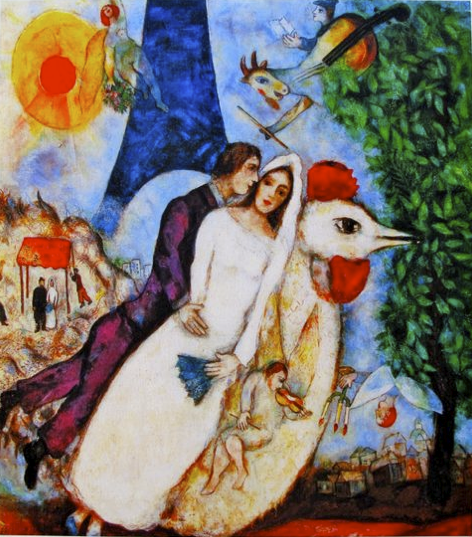 |
| The Bride and Groom of the Eiffel Tower Marc Chagall 1939 |
For much of my life, I have been an admirer of Marc Chagall's work. The mystical movement that he captures on canvas is so poetic in nature that his paintings seem to dance to the rhythm of a musical score.
Many of his paintings seem like representations of my own fanciful dreams, dreams to which I am prone but cannot manifest artfully onto canvas.
Poet and critic Guilluame Appollinaire once said that Chagall's work is "supernatural." Here. Here. I couldn't agree more. For this reason, Chagall's paintings move me to my core.
The Bride and The Groom of the Eiffel Tower recently caught my eye because Chagall painted a rooster behind the bride and the groom. It's as if the newly-wedded couple is riding upon the rooster's wings--like a magic carpet ride, the rooster lifts them into the sky and toward the heavens. The bride and groom's feet are no longer firmly planted on the ground. Instead, they are drawn into flight.
According to Art Revived, the cow that turns into the fiddle in the upper right of the painting is supposed to represent the nursery rhyme about the cat with the fiddle and the cow jumping over the moon. The rooster is supposed to come from another unnamed nursery rhyme.
Unnamed nursery rhyme? Personally, I wonder if Chagall wasn't referencing the ancient Greek meaning of rooster as a harbinger of the sun. In Chagall's painting, there are two suns: the actual sun in the upper left corner and the rooster carrying the couple. Marriages are new beginnings, a time where the "light" shines doubly-bright. A marriage of love brings connection; hope, and a kind of warmth and security that spawns growth.
The Eiffel Tower is considered to be one of the seven wonders of the modern world. The wedded couple stands in front of the Eiffel Tower. Chagall lived much of his life in France, so that could be the reason for the Eiffel Tower. But, the Eiffel Tower could also represent the structure of marriage--the stretching of love to its tallest point, reaching high for the sky and the stars while resting on a strong, solid, and wide base of supportive family and friends.
When I visited the Eiffel Tower years ago, I laid on my back on the cement underneath the tower and aimed my camera up into the tower's "belly". I shot photo after photo after photo until I ran out of film. I was fascinated by the tower's divine webbing, how its interlaced metal joined together to create a piece of art that was as intriguing as it was entertaining. It was like lying under the Great Pyramid and feeling the energy of the many hands that went into its building.
The suns, the fiddles, the wedded couple and the Eiffel Tower--Chagall understood that love is a gentle dance played by fiddlers under the glow of two suns. He knew that upon a rooster's back, a perspective is gained of the heaven and skies that only a couple with courage to fly can see. And, perhaps, he knew, instinctively or not, that marriage, and the duration of it, is the eighth wonder of the modern world.
What I love best about art is that it has different meanings for each person. Does Chagall speak to you?
For more information on the ancient meanings of the rooster, check out my previous blog post, Harbingers of the Sun.

Wow. A beautiful meditation on a beautiful piece of art. Nice, Nancy.
ReplyDeleteHello, I'm an Art student. I chanced upon your blog while researching on Chagall and I really love the way you write :') Just wanted you to know that.
ReplyDeleteDear "anonymous": Thank you for your reply. I wish you much good fortune with your artistic endeavors and hope that one day I will be writing about your work!
Delete